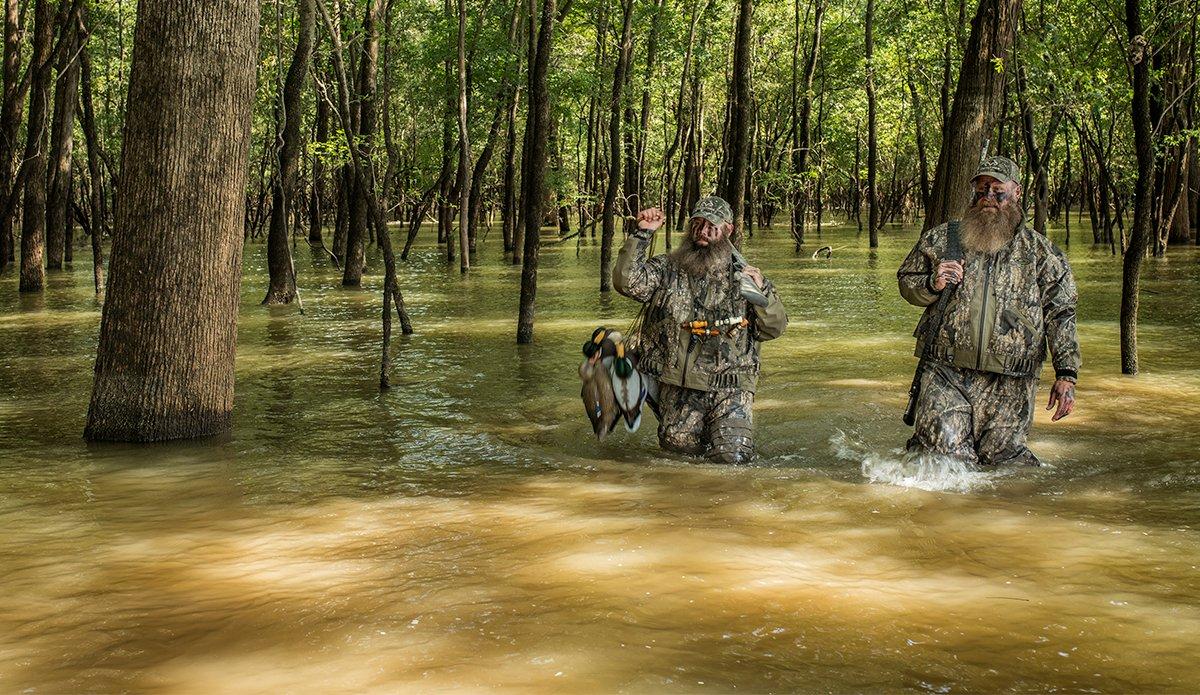Maximize Micro-Spreads This Waterfowl Season
Some days, you can only tote a few decoys to your duck or goose hotspot. Maybe you have to slug through a half-mile of prairie to reach a pothole, or perhaps you need to hoof a few full-bodies over a wet, muddy barley field to set a honker trap.
Whatever the case, you can't always set a 100-plus-fake monster spread. And in those situations, you risk sacrificing realism. Think about the two most common small-spread configurations: the stool, which is essentially just a blob of decoys; and the two-group set, which is basically just two small stools separated by an open landing area. Often, those layouts work just fine, as ducks might buzz them, or something at the area — food, safety or roosting security — attracts birds more than the decoys. But other days, a tiny spread can look ridiculously inadequate and unrealistic, and it might hinder success. That raises the question of how you can make your setup appear real when you're restricted to, say, fewer than two-dozen blocks.
Let's look at some common small-spread scenarios and examine solid setups for each.
Potholes or Small Sloughs
I've enjoyed hundreds of great pothole shoots over spreads of 13 to 20 decoys. Granted, many of those were in the Dakotas, where ducks aren't as wary as a Mississippi Flyway mallard in January. But the tactic has also worked frequently on my home water.
Before setting blocks, consider the circumstances. If you're hunting a point during breezy conditions, it makes sense to use the two-stool approach, setting one group of decoys upwind and tighter to shore and the other downwind in a somewhat looser configuration. Puddle ducks should want to land in the open hole, and divers will often swing over the downwind stool and plop down in the hole.
On calm days, when ducks naturally spread out on the water, it's more practical to fashion a long, loose blob of decoys in front of the point or shoreline, extending relatively far downwind and upwind. Spread blocks out farther than normal to give the impression of relaxed, loafing birds.
Creeks or Small Rivers
These setups can be tough. Hunters always want to set conventional spreads in moving water, but they neglect the biggest variable: current.
Remember, ducks and geese don't want to swim hard all day any more than fish want to fight swift flows. Trout seek eddies and other current breaks. So do waterfowl. Your decoys must reflect that.
Small oxbows or calm flats off creeks or rivers offer ideal setups. I'll usually place a dozen or so blocks in the calm water, even if it's fairly tight to shore, to represent content, relaxed birds loafing out of the current. Then, I'll add one or two farther out in the flow for added attraction and to represent birds that have just landed and are swimming toward shore. That might be overthinking things, but the setup usually works.
Fields
Pacific Flyway reporter M.D. Johnson wrote an excellent piece on micro-spreads for geese, so I'll try not to steal his thoughts. First, whether I'm hunting ducks or geese in a field and I'm limited to a few decoys, I'll only use Canada goose fakes. Everything will decoy to them — period. Second, I try to mimic what I've seen birds do at that location. If honkers were in two or three family groups tight to the edge of a winter wheat field, I'll split 20 full-body decoys three ways to mimic that. If birds were spread out feeding aggressively across a long field, I'll set my fakes in a long, loose line or oval. Above all, seek maximum visibility and realism. Use several decoys with various body postures; some feeders, a few lookers and some loafers. Mix and match them to make the scene appear real.
Larger Water
This might be the toughest small-spread scenario, but it doesn't assure failure. I've actually had some good diver hunts on big water — like 100,000-plus-acre big water — with fewer than two-dozen decoys. Ideal? Heck no. But you can make it work.
The most important consideration is to hunt areas where decoys don't matter as much, such as points off deep bays or channels between two larger waters. Such areas will naturally attract and funnel ducks, and your decoys just complete the setup. Second, spread your decoys out considerably to maximize visibility at long distances. Divers might barely notice glimpses of white from a tightly packed 20-decoy stool. They're more likely to see blocks stretched 50 to 60 yards wide.
Oh, and if you can't make a downwind tail with your small spread, consider setting a large white decoy downwind as a tolling block — something to grab the attention of passing ducks. It works.
Small Matters
Don't get frustrated this season when your decoy options are limited. Observe each situation, and set small spreads to maximize opportunities. Maybe 10 dozen blocks would work better, but 20 or so can work just fine if you deploy them correctly.
Click here for more Realtree waterfowl hunting content. And check us out on Facebook.







